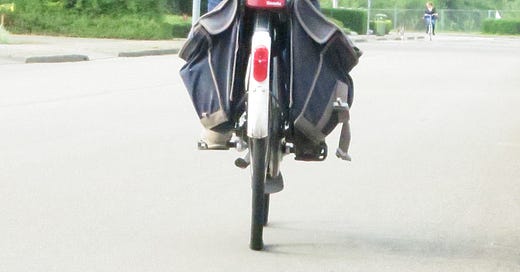Dear reader,
The Dutch are rule-followers for the most part. They may complain about the rules, and how the government has rules for everything, but they mostly follow them.
Except when they get on a bicycle. Something about that simple act turns ordinary Dutch people in anarcho-terrorists.
Kids on bikes
It’s not like they don’t know the rules; they do. In elementary school children have lessons teaching proper bicycling behavior. They learn who has the right of way in any given traffic situation. They learn the road signs that are relevant to bicycling. They learn about the importance of signaling and using proper bike lights. They take a road traffic test and get their bikes officially inspected.
Outside of elementary school, though, all of that goes out the window. Secondary school children on their way to school routinely ride three or four next to each other, even though the legal limit is two. They don’t signal, and generally ignore the world around them. Of course, that’s pretty standard behavior for adolescents, who all go through a phase of seeing themselves as the center of the world.
Adults on bikes
It isn’t just about the kid, though. Kids make poor choices; that’s normal. It’s the adults too. Adults on bikes can be even worse than the kids. Here are some things I’ve seen:
Parents carrying their kids not in child seats but standing on the bar in front of them and/or on the rack behind them.
People taking short cuts down pedestrian paths, swerving around dogwalkers and elderly people using walkers.
In Amsterdam, where tourists crowd the streets and bike paths, bicyclists simply ringing their bike bells repeatedly and not slowing down at all when tourists walked in the bike path.
Bicyclists riding straight out from a side street into the road in front of moving traffic.
A bicyclist riding on the right side of the road in the same direction as the traffic suddenly, mid-block, shooting out diagonally across the road in front of my car, forcing me to brake hard. This has happened more than once.
Hobby cyclists – the kind wearing spandex on racing bikes – riding through the city, zipping much too quickly by small children wobbling their way down road.
Bicyclists in parking lots riding between rows of cars, not even changing path or swerving when a car was backing out of a space toward them.
Bicyclists passing a car on the left, even when that car was slowing down and signaling that it was turning left.
People carrying things on their bikes that were not attached, so that they held the thing with one hand and steered with the other. Often this is a crate of beer. One time I saw a person carrying a bookcase on the back of his bicycle. He had put it on crosswise, so it stuck out on both sides. He was holding it onto his bike behind him with one hand and steering with the other. I saw a person once carrying a bike across the back of his bike the same way.
People on bicycles holding an umbrella. Have you ever tried that? I have. Given the wind you create with your forward motion, the umbrella has to be dipped down a bit in front or it will catch the wind and be pulled behind you. The problem is, with the umbrella down in front, you can’t see more than a couple of meters of the ground in front of you.
People on two bikes next to each other holding hands, or carrying something together, or holding on to each other’s handlebars.
People being pulled along by a motorbike, having a nice chat with the driver.
Most commonly, lots of people bicycling in the dark without any lights on their bicycles.
Combinations of the above, such as crossing the street in front of traffic without lights on the bike.
In most of these situations, they can’t (or just don’t) signal either.
While they’re doing all of these clearly dangerous things, only the hobby cyclists wear helmets. No one else does, except the occasional very small child, still learning to cycle. Helmets? “We don’t need helmets here. They’re for Americans and Germans.”
How is this possible?
So why is total anarchy on bikes acceptable? Because if there is an accident, the laws favor the cyclist.
If a cyclist causes an accident with a car, and the cyclist is under 14 years old, the driver of the car is taken as entirely responsible for any damage.
If the cyclist who caused the accident is 14 or older, they’re still only responsible for 50% of the damage. And that assumes the driver can prove that the cyclist caused the accident.
Car drivers, then, do everything they can to avoid accidents with bicyclists. That’s a good thing, of course. Drivers should avoid accidents. That goes without saying.
Here’s the problem: this makes cyclists feel that they can do whatever they damn well please since they know that the driver will try their best to avoid an accident. It makes them cocky and careless.
The result: complete disregard for the rules.
Met vriendelijke groeten (friendly greetings) from your stressed-out driving friend,
Rachel
I write about independent travel at Rachel’s Ruminations. Please join me there!




Wow!! That’s crazy!